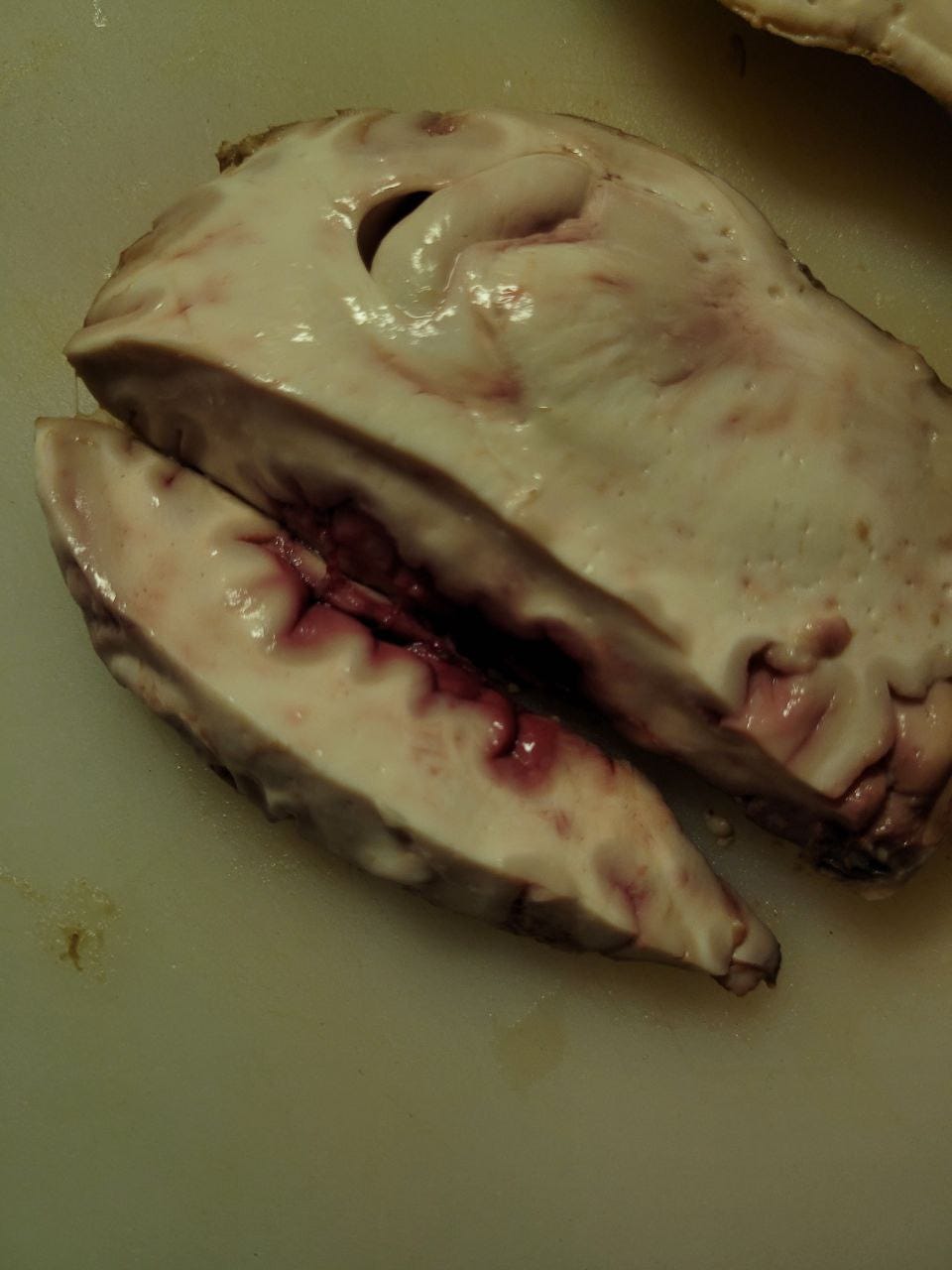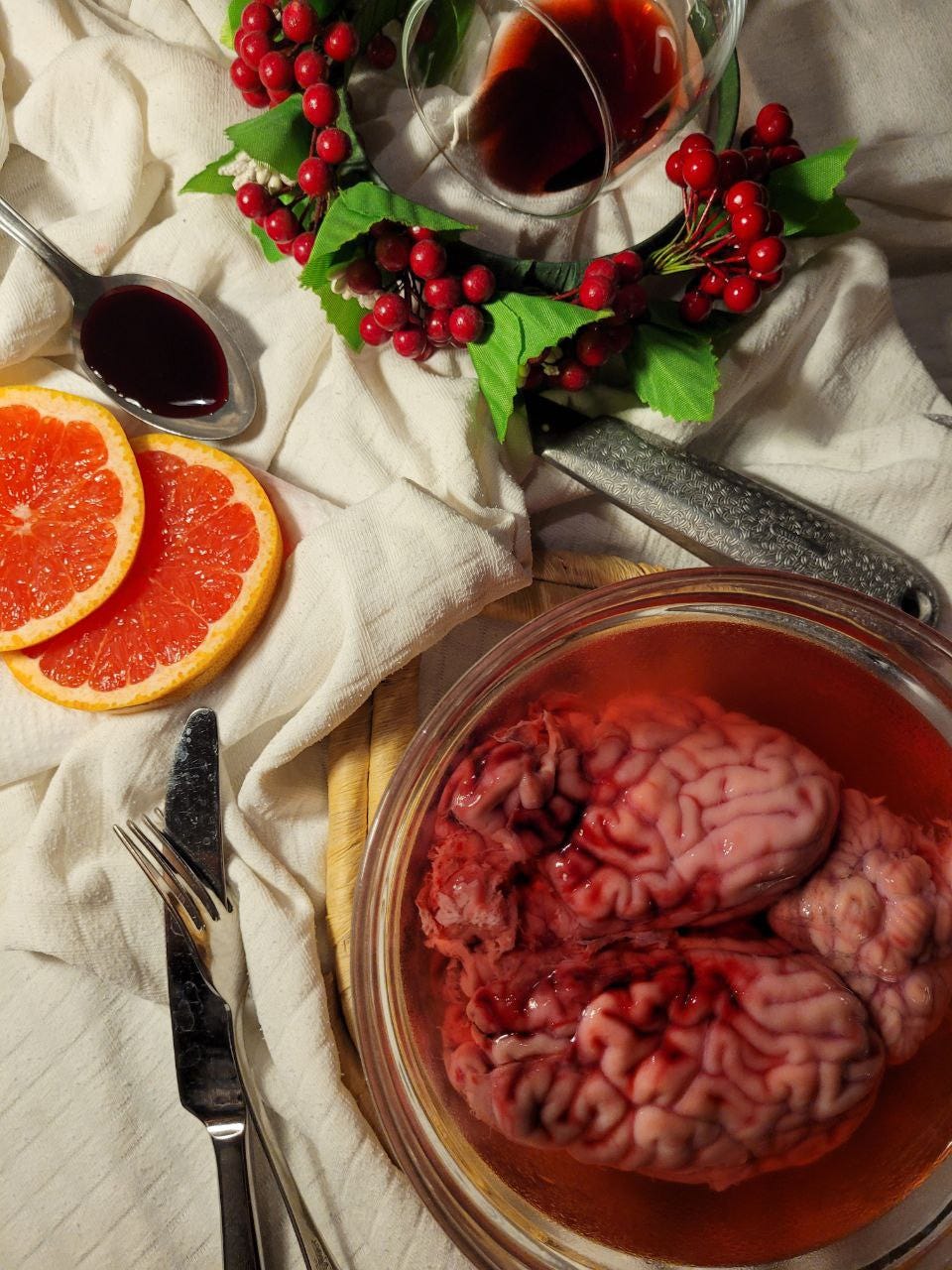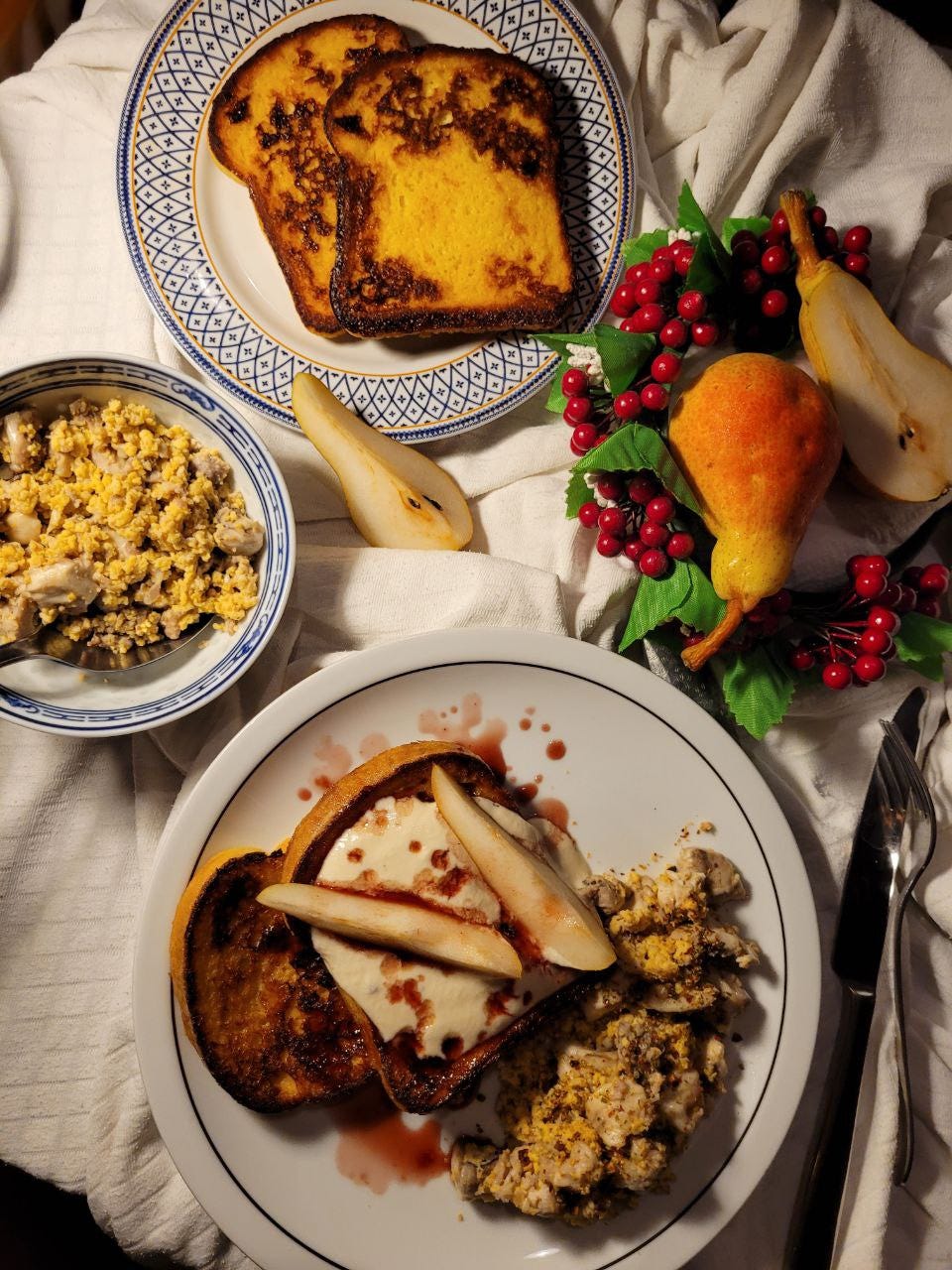Technically, it wasn’t my physical brain but the idea did come from me and I paid for it so does it mean it’s my brain that I scrambled? Meh, who knows.
I think the first time I had brains was a lamb brain. I was working at a restaurant in New Delhi and we had to make bite-sized food for the restaurant’s launch. I didn’t care much for the vibe of that party; my attention was on the brain. It seemed so…fluid, like room temperature butter, but doesn’t dent like so. The taste was immaculate, though, that much I can say for certain. And then I didn’t eat any brain, except for my sisters’, for a long time.
Until last year. My thesis was part research and part recipe book. Well, it was 90% research, because academia. And I wanted to research why we stopped consuming organs anymore like we used to.
I know there are quite a few myths about the dangers of eating a brain, like the very real likelihood of contracting bovine spongiform encephalopathy (BSE). I will go into the science and research behind it in another post but a lot of cultures eat and celebrate brain as an ingredient! The French eat cervelle de veau and tête de veau, we have maghaz in and around the Indian subcontinent, gulai otak from Indonesia, tianma zhunao tang from south China that uses pig brain, brain masala curry from the south-western Indian city of Bombay, the Mexican tacos de sesos, and so much more.
For my thesis, I scored a brain from a hypermarket in Italy called Metro. Honestly, I almost passed by it as I was taking a stroll in their meat section, like one does. They had a whole selection of meat parts - the usual muscles and then you have the intestines, beef cheeks, tail, goat hooves and more. I passed by a shelf where the brain had no business being in (the accompanied parts were more to the south of the body) and I almost didn’t see it. It was packed in a small plastic container and I wish someone would have taken a picture of me as I saw the brain. It was a cervello di vitello or a calf brain. Honestly, I thought the calf brain would be much smaller but I was surprised by how big it is. On that note, I should remind myself that animal organs are fairly larger than human ones, even if the animal in question is not an adult.
When I got the brain, I got to researching a bit on how to handle it. I mean, sure, I cannot handle the one I already have attached to my body but the least I could do with the calf brain was treat it right. I came across Janine Farzin’s website Offally Good Cooking (really enjoying all the offal related puns we all get into) which guided me on how to clean and cook the brain before actually cooking it. Janine’s website is really wonderful - not only does she have recipes for obscure bits, she also has researched methods on handling those bits.
Let’s get into it, shall we?
While it isn’t the most difficult to handle, I would still be gentle. It feels like room temperature butter and if you keep poking it, it will fall apart (much like our own). You don’t technically have to poach it - but do soak it for anywhere between 30 minutes to 2 hours, and remember to change the water if it’s longer than 30 minutes.
A lot of offal enthusiasts will recommend to soaking your brain (hah!) in a bowl of water with a spoonful of vinegar mixed in. Some soak it in milk, and some, like me, soak it in just plain water. Especially since I am planning to change the water - it doesn’t make sense for me to soak it in milk but I assume if you soak it in something like milk, you don’t technically change it as much. When I purchased the brain, I didn’t immediately cook it, so I froze it. Upon freezing, you have 3 months to use it up. To thaw it, simply put it back in the refrigerator part overnight and let it naturally thaw a bit. If by the time it still hasn’t thawed completely, soak it in water!
Take care to clean the meninges off the brain gently; try to do it when it’s submerged in water as it is easier to pull them away. Do not, for any reason whatsoever, run the brain under a tap. It will break the segments off and you will be left with the pieces of a brain so broken no therapist would be able to help. Sorry, it was right there.
If you want to poach it, you can do it in simple salted water which you will bring to a boil and then lower the heat to bring it down to a simmer. Gently add the brain into the water, cooking it for 15 minutes for lamb, 20 for veal or pork and 30 for beef. You can use an actual broth to flavour it. I, personally, did not like what the broth tasted like after I was done cooking the brain in it but you can use it to store leftover brain or use it for other things. Of course, if you are using the brain for something like a “brain-chocolate mousse”, you will not salt the water too much, just a pinch will suffice.

As with boiling milk, try to not do major things around the time the brain is poaching. The brain can easily fall apart if cooked too long. Remember that you can still use a raw brain in your recipe and cook it directly without poaching it first. So, the goal is to make sure the outside is a bit firm but the inside should resemble that of silken tofu. Either you let it cool down in its broth or take it out of the broth and let it come to room temperature or give it an ice bath (submerge it in a bowl full of water and ice cubes).
And then, you follow whatever the recipe tells you to! In this case, it’s my scrambled brains and I promise you, it’s tasty!
Scrambled Brains:
What you will need:
Raw/poached brain - 1/2 of the one you have
Salt - to taste
Eggs - 2 whole, medium/medium large
Any spices mixes you might have - I had pepe rosa e limone spice mix (pink pepper and lime)
Butter or oil - I used a mix of both
What you need to do:
I usually like my scrambled eggs a bit loose and not too dry but the dry ones worked well because the brain adds that mushiness of the whole dish. Beat two eggs in a bowl, don’t add salt yet.
Cut the brain in small, uniform cubes. You could go small enough to resemble minced garlic but at that point, just run it through a mixer!
On a pan in medium heat, add butter/oil/both or, if you are ambitious enough, lard! Using both oil and butter reduces the risk of burning the butter! Once it’s hot enough, add the brain and cook well for about a minute or two or until it’s a bit dried. Sprinkle salt as you go.
Add the eggs. Now here is where I tell you that if you don’t want the eggs to coat the brain, then the eggs go first. If you are okay with the eggs coating the brain, then the eggs can come second.
Mix well and add your salt and seasoning. You can still keep the eggs a bit runny or you go a bit on the drier side (sorry Gordon Ramsay, you’d hate my scrambled eggs). And you are done!
I would say scrambled eggs and brain are a pretty easy way to get used to cooking with brain. Not only do you understand how to cook a brain, you do it in the simplest way ever. After I made this, I felt like I could conquer the whole world but it was August in Italy so best I could do was go sleep.
I paired my scrambled brains with French Toasts, pears and whipped cream cheese and yogurt. I had some cherry syrup I was experimenting with, so added that for an artistic effect.
I genuinely think we overlook brain as an ingredient in our diets. The only reason you might want to avoid brain is it’s cholesterol level. For every 85gms, you will find approximately 879% of cholesterol. Which is, I mean, certainly not ideal. Although, the brain has zero carbs and is high in protein and fat. It is an excellent source of Vitamin b12, copper, and phosphorus.
Is it time to die yet?
Well, no and while I will dive into this spiel that is Bovine Spongiform Encephalopathy at some point in the near, foreseeable future, I would still like to address it however minutely I can.
Also called the mad cow disease, bovine spongiform encephalopathy (BSE henceforth), is a progressive neurologic disease that infects cow, in which “progressive” means that it gets worse over time and “neurologic” means it attacks the nervous system (the brain and the spinal cord). (FDA, 2020) The reasons for BSE to randomly appear in a cow is still being studied but it is known that a protein called “prion” is involved in that the normal prion protein changes, at random, to abnormal prion protein. The abnormal prion protein is sneaky because the cow’s body does not even know the prion protein has actually changed into the abnormal type and as long as the body, animal or otherwise, does not think anything is wrong, it does not fight it off. I mean, logically, that checks out.
Do humans get BSE? Yes, sadly and it’s quite fatal, too. Although, it’s not BSE they get, it’s a variant called variant Creutzfeldt-Jakob disease (vCJD). A total of 232 people worldwide were known to have gotten sick with vCJD and have, unfortunately, all passed away. This doesn’t necessarily mean they all ate a brain from a sick cow and died. Regardless of what part of the animal you eat, if the cow has BSE, even the flesh would be likely that you will get vCJD. Interestingly, you can consume the milk of a sick cow and you would not be affected. More, in-depth details about this later!
I mean, you could get sick from…name it. If you get blood from a person infected with vCJD, you are likely to get mad cow’s disease. But as with all things, that would be pretty unlikely.
The trick to being safe with your purchased meat is to source it directly from your butcher or local producer. That way you not only have a great relation with a small scale farmer but also know exactly where the food you are purchasing is coming from. I mean, that’s a healthy practice even for vegetables. But I understand, living in a city can get super busy and most of the time you are barely surviving. So, the least you can do, when you can, if you can, is talk to your local butcher!
Also, if you are killing an entire animal, might as well eat as much of it as we can, no?

While it will be a while before I make another brain recipe but if you want me to try something out in the future,
We can discuss it in depth, you will be featured on my newsletter and hey, we get to eat brains!





